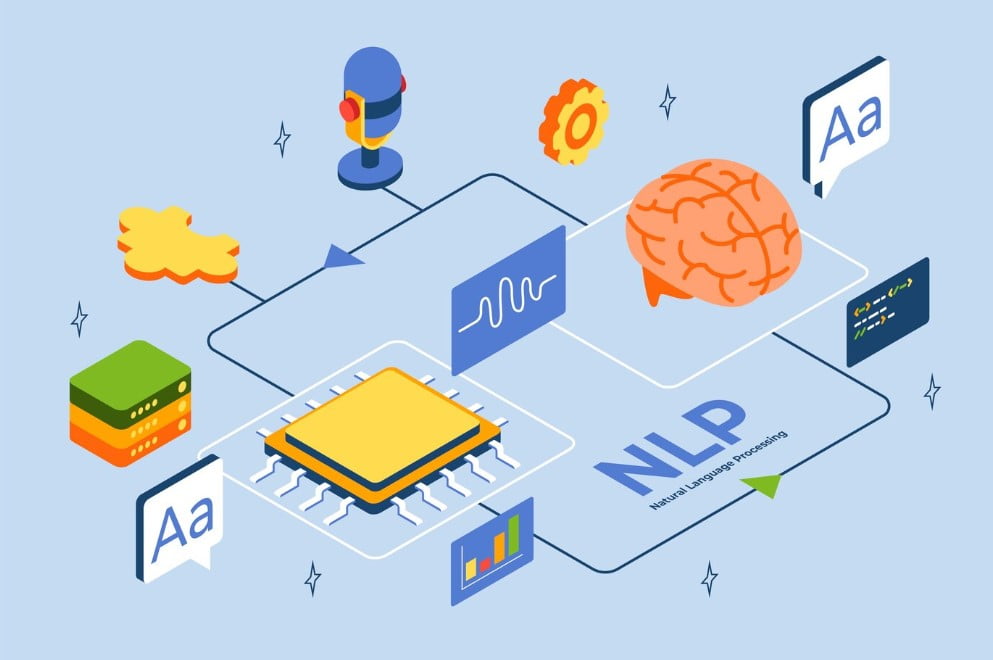Welcome to our comprehensive guide on natural language processing algorithms. As you know, language is a complex and nuanced tool for human communication, but machines struggle to understand and interact with it effectively. That’s where natural language processing algorithms come in – they unravel the intricate patterns of human communication and enable machines to interpret language with greater accuracy and efficiency. In this guide, we will take a deep dive into the world of NLP algorithms and explore their significance in language processing. Let’s get started with the fundamentals of NLP models and how they are the backbone of natural language algorithms.

Table of Contents
Understanding Natural Language Processing Algorithms
Have you ever wondered how machines can understand human language? Natural language processing (NLP) algorithms make it possible. Before we dive into the intricacies of NLP algorithms, it’s vital to understand their underlying concepts. NLP models serve as the backbone of these algorithms, enabling machines to decipher patterns in human language and respond accordingly.
Natural language processing algorithms are a subset of language processing algorithms that enable machines to interact with natural human language. These algorithms involve parsing, understanding, and generating human language in a way that humans can interpret. When it comes to NLP models, it’s crucial to understand the concept of semantics, which refers to the meaning behind words and sentences.
The primary goal of Natural language processing algorithms is to enable machines to understand human language regardless of linguistic variations such as vocabulary, grammar, and context. In essence, the fundamentals of NLP models revolve around syntax, semantics, and pragmatics.
Therefore, NLP algorithms play a crucial role in various applications, ranging from virtual assistants to automated translation tools. In the next section, we will explore the programming language algorithms used in NLP and their significance in creating robust NLP systems.

Programming Language Algorithms for NLP
In the realm of natural language processing algorithms, effective NLP solutions require skilled programming. The core of such programming lies in using programming language algorithms. This section will explore various programming language algorithms that are applied in natural language processing to create robust NLP systems.
Programming language algorithms play a crucial role in building NLP engines that can analyze and understand human communications. They are used to extract meaning and context from large volumes of text data. The most common programming algorithms employed in NLP are:
- Finite Automata algorithms – used for pattern recognition in language processing
- Context-Free Grammar algorithms – enable the generation of phrases and sentences
- Hidden Markov Model algorithms – used for speech recognition and text classification
These algorithms work together to enable machines to communicate and understand language as humans do. By using various programming language algorithms like these NLP algorithms become much more effective.
This creates considerable opportunities to automate communications, enhance language-based customer service, and make language-based automation much more efficient.

Unveiling the Power of Machine Learning Algorithms in NLP
Machine learning algorithms have played a significant role in advancing natural language processing. These algorithms are designed to learn and improve from experience, allowing them to effectively understand and process human language.
One of the most significant applications of machine learning algorithms in NLP is in sentiment analysis. This algorithm enables machines to analyze and understand the sentiment behind a piece of text, making it a valuable tool for businesses looking to monitor their brand reputation.
Another essential application of machine learning algorithms in NLP is in language translation. These algorithms can analyze and translate text from one language to another, making it easier to communicate and do business across borders.
Machine learning algorithms also play a crucial role in speech recognition. By analyzing and understanding the patterns of speech, these algorithms can accurately decipher spoken language into text, making it a valuable tool for various industries such as healthcare and customer service.
Overall, machine learning algorithms have paved the way for significant advancements in natural language processing, allowing machines to understand and interact with human language more efficiently and accurately.
Advanced NLP Techniques for Text Analysis
When it comes to text analysis, Natural Language Processing (NLP) techniques have revolutionized the way machines decode and comprehend human language. These advanced techniques are used to extract valuable insights from large volumes of text data, helping industries streamline processes and gain competitive advantages.
Sentiment Analysis
Sentiment analysis is a popular NLP technique used to determine the emotional state of a piece of text. This process involves identifying and extracting subjective information from the text, such as opinions and attitudes, allowing businesses to better understand customer sentiments and improve marketing strategies.
Named Entity Recognition
Named Entity Recognition (NER) is an NLP technique used to identify and extract information from text that pertains to a specific entity, such as a person, organization, or company. This technique is particularly useful for businesses looking to track brand mentions and improve their online reputation management.
Topic Modeling
Topic modeling is an NLP technique used to uncover hidden patterns and themes within large amounts of text data. This technique works by identifying common themes and grouping them together, allowing businesses to gain a better understanding of customer preferences and tailor their products or services accordingly.
Text Clustering
Text clustering is an NLP technique used to group similar pieces of text together based on their content. This technique is particularly useful for businesses looking to segment their customer base and develop targeted marketing strategies to specific groups.
Incorporating these advanced NLP techniques into your text analysis strategy can provide a range of benefits from improved customer sentiment analysis to increased efficiency and productivity. By leveraging the power of natural language processing algorithms, businesses can gain a competitive edge and enhance their understanding of customer needs and preferences.
Enhancing NLP Algorithms with Deep Learning
Deep learning, a subset of machine learning, has had a significant impact on natural language processing algorithms. By analyzing vast amounts of data, deep learning algorithms can learn to recognize complex linguistic patterns and structures. This allows them to generate more accurate and effective responses to natural language queries.
Through the use of deep learning techniques, NLP algorithms can be enhanced in several ways:
Improved Language Understanding
Deep learning models can be trained to recognize the nuances and intricacies of human language, allowing machines to better understand natural language queries and responses. This results in more accurate language processing, and ultimately, better communication between man and machine.
Enhanced Language Generation
Deep learning models can also be used to generate natural language responses to queries. These responses can be tailored to specific contexts and can even incorporate sentiments and emotions, making them more human-like in nature.
Increased Efficiency
Deep learning techniques can significantly improve the efficiency and speed of NLP algorithms, making them more scalable and cost-effective. This enables their use in a wider range of applications and industries.
Overall, the use of deep learning techniques represents an exciting advancement in the field of natural language processing algorithms. With continued research and development, we can expect these algorithms to become increasingly sophisticated and effective in the years to come.
Overcoming Challenges in NLP Algorithm Development
Developing natural language processing (NLP) algorithms that effectively decode language patterns can be challenging. Here are some common obstacles you may encounter in NLP algorithm development, along with strategies to overcome them:
1. Data Limitations
Access to large amounts of labeled data is crucial for training NLP algorithms. However, data in certain languages or domains may be limited, making it challenging to build robust models. To overcome this challenge, you can explore options such as data augmentation, unsupervised learning, and transfer learning.
2. Ambiguity in Language
Language is often ambiguous, with multiple meanings assigned to the same word or phrase. This can make it difficult for NLP algorithms to accurately understand and interpret language. To address this, you can incorporate techniques such as word embeddings, part-of-speech tagging, and named entity recognition to provide more context to the algorithms.
3. Unstructured Data
Most natural language data is unstructured, making it challenging to extract valuable insights. In this case, you can adopt advanced NLP techniques such as topic modeling, text summarization, and sentiment analysis to gain a deeper understanding of the text data.
4. Algorithm Complexity
With the increasing complexity of NLP algorithms, it can be challenging to optimize them for scalability and performance. To address this, you can use tools such as distributed computing, batch processing, and caching to improve algorithm efficiency.
By understanding and overcoming these challenges, you can build effective NLP algorithms that decode the intricate patterns of human language and improve communication between humans and machines.
Applications of Natural Language Processing Algorithms
With the ability to understand and decode human language, natural language processing algorithms have found applications in various industries and fields. In this section, we will highlight some of the key applications and their impact.
Chatbots and Virtual Assistants
One of the most common applications of NLP algorithms is in the creation of chatbots and virtual assistants. With these algorithms, machines can understand and respond to human language, effectively mimicking human-like conversation. Chatbots and virtual assistants have found applications in customer service, healthcare, and education, among others.
Sentiment Analysis
NLP algorithms can be used to analyze text data and determine the sentiment behind it. This has applications in social media monitoring, brand reputation management, and market research. By analyzing the sentiment behind customer feedback and reviews, organizations can gain valuable insights into customer perception and preferences.
Machine Translation
Another significant application of NLP algorithms is in machine translation. With these algorithms, machines can convert text from one language to another, eliminating language barriers that may hinder communication or business operations. Machine translation has found applications in international business and diplomacy, among others.
Content Recommendation
NLP algorithms can also be used to analyze text data and recommend relevant content to users. This has applications in e-commerce, social media, and entertainment, among others. By analyzing user preferences and online behavior, organizations can recommend personalized content, improving user engagement and satisfaction.
With these applications and more, natural language processing algorithms are transforming the way we interact with machines and each other, opening up a world of possibilities for improved communication and productivity.
Conclusion
In conclusion, you now have a comprehensive understanding of natural language processing algorithms and their significance in shaping the future of human-machine interaction. As you have learned, NLP algorithms play a vital role in unraveling the intricate patterns of language, enabling machines to interact with humans more effectively. From understanding the fundamentals of NLP models to exploring programming language algorithms and machine learning techniques, you now have a thorough understanding of the technology behind these algorithms.
You have also gained insights into the various advanced NLP techniques used in text analysis and how deep learning techniques can enhance the capabilities of NLP algorithms. Moreover, you have learned about the applications of NLP algorithms in various fields, from chatbots and virtual assistants to sentiment analysis and machine translation.
As technology continues to evolve, you can expect NLP algorithms to become even more advanced, addressing the challenges of language understanding and processing with greater efficiency.
Thank you for taking the time to explore the world of natural language processing algorithms with us. We hope that this guide has been informative and has provided you with valuable insights into this exciting field.




